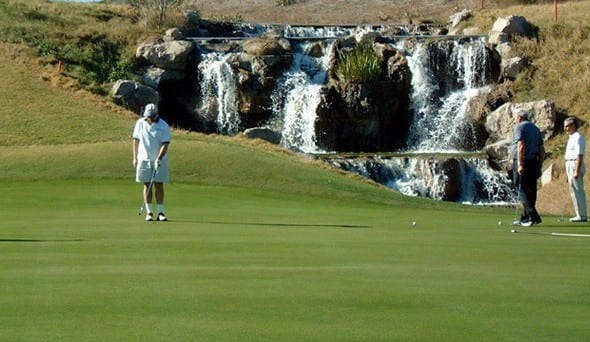Three Hazards to Avoid When Playing Golf
Posted in News -

Specialty construction companies like Outside the Lines have helped make golf great by designing and building natural, realistic hazards that enhance the sport. As a golfer, it’s only natural to develop a love-hate relationship with different hazards on the course. As your skills increase, you will find ways to use some hazards to your advantage, while other hazards will inevitably work against you.
How you view hazards on the golf course depends on a few factors. The main factor is who you are playing against. If you’re going for an all-time score against yourself, you might view each hazard as an obstacle keeping you from your world record. However, if you’re playing against someone else, or you’re in a tournament, the hazards are not only obstacles for you, but for your opponent, too.
When you keep score against another player, hazards on the golf course may work to your advantage if you can avoid them. At the same time, you may hope that your opponent does not have as much luck. For example, if you can hit the ball far, you may be able to clear the water hazards or make it over the sand bunkers. If you know how to put a fade in your swing, you just might make it around the overgrown grass or streams.
“When golfers talk about hazards, they generally mean anything on the golf course that may be detrimental to their score. This could be thick brush next to a green, a tall tree in the middle of the fairway, or a winding brook next to a bunker. Basically, anything that provides a difficult obstacle on a golf course is a hazard. According to the official Rules of Golf, though, hazards fall into two categories only: bunkers and water.”
The three types of hazards are usually man-made (bunkers), water and natural (vegetation)
1) Facing a Water Hazard on the Golf Course
Water hazards, like meandering streams with ponds and waterfalls, not only enhance the natural beauty of the golf course, but add an interesting challenge to the game. When you approach a stream, you’re often drawn to the energy of the moving water and its sound as it flows over the rocks and meanders its way to the ponds. This moment of tranquility is short-lived when you face the reality that to play the game, you have to get your ball around the stream or over it.
2) Up Against a Bunker on the Golf Course
Once you get your ball over the stream and onto the greens, you need to keep your ball out of the bunkers. If your ball goes into the bunker, you’ll have to get the ball out. Sometimes, you can use a special club designed for this obstacle, but other times you may end up losing a swing or two as you try to get back into the game.
3) Playing Through Vegetation
Other interesting obstacles you may face on the golf course are plants, trees and tall grass. While these may or may not be as difficult as water hazards and bunkers, you want to avoid them at all costs. Hitting your ball into the trees or overgrown brush will make it difficult to set up your next shot or cause you to lose a shot entirely.
Not only are hazards on the golf course amazing displays of natural beauty, but they are also an important element to the game of golf. Their design and placement are crucial to the quality of the golf course.
Create natural-looking hazards on your golf course by enlisting the highly skilled design/build professionals at OTL. Its team of highly skilled artisans and designers create realistic environments with an accurate sense of the natural randomness of nature.
If you would like to work with a team of highly skilled artisans and technicians who have created natural hazards at golf courses around the world, please contact us at: (714) 637-4747 or email us at info@otl-inc.com
Featured Articles
- Getting to Know OTL’s Administrative/Accounting Assistant Nathan Touche
- Centers With Well-Designed Experiential Water Features Can Attract 30,000 Visitors Per Week
- Fountains of Light: California Water Features Developer Opens North Texas Office
- AI and Facility Management: How to Avoid Potential Pitfalls
- Safety First and Last: Creating a Safe Site in any Environment


